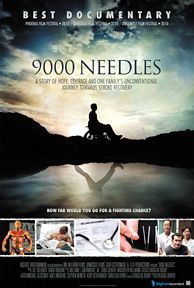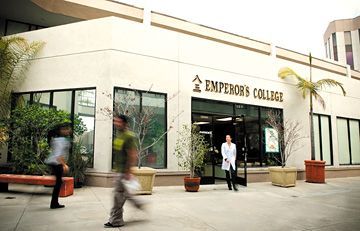Whether you accept it, avoid it or live somewhere in between, insurance coverage has become a defining issue for our profession. Patients increasingly expect to use their benefits, practitioners want to be compensated fairly for their time and expertise, and the system itself remains – at best – fragmented. The encouraging news is that coverage has expanded in meaningful ways. The challenging news is that reimbursement, across the board, remains inadequate.
Realizing a Life Long Dream
A lot of acupuncturists were enthusiastic about the release of 9000 Needles, but perhaps none more than Atsuki Maeda. The documentary follows an American stroke victim to China, where he receives acupuncture from a team of doctors led by Shi Xue Min—Maeda's teacher. After completing acupuncture school in Japan, Maeda participated in an exchange program that sent recent graduates to China's renowned First Teaching Hospital of Tianjin University of Traditional Chinese Medicine. While there, he became one of the first students to get certified in Xing Nao Kai Qiao Fa (known as XNKQ), a form of stroke therapy developed by Dr. Shi. It has been Maeda's dream ever since to expand awareness and accessibility of this powerful treatment.
9000 Needles has been a huge blessing in this regard — and has created much demand for XNKQ-trained acupuncturists in the U.S. In response, Emperor's College in Santa Monica, Calif., recently hired Maeda to lead its XNKQ stroke rehabilitation and prevention module, a new required component of the school's doctoral program. In June, Emperor's College launched the Stroke Rehabilitation & Dementia Care Center, where Maeda treats patients and leads clinical rounds for the students who will eventually join him as XNKQ-certified acupuncturists.

SC: How is XNKQ different from conventional acupuncture treatments for stroke, such as scalp acupuncture?
Atsuki Maeda: If you go online and type in "acupuncture" and "stroke," you will find several studies that say acupuncture is ineffective. But if you dig into those studies and look at the points, they are always using conventional point prescriptions, which are focused on yang meridians. XNKQ therapy takes a different approach. In the classics, points indicated for stroke are mainly from the yang meridians. In the XNKQ protocol, we use points mainly from the yin meridians. In TCM theory, the brain falls into the category of what we call Extraordinary Fu. Fu is a type of organ that is considered yang, which means it is empty and hollow. The other kind of organs are called Zang, which are yin and considered solid; they're the ones that play major roles in our lives. XNKQ differs in that it considers the brain a yin organ. This is a significant shift in how we think about the brain and it's the main reason the XNKQ method is so effective compared to others.
SC: Is XNKQ a defined protocol or are points selected based on symptoms?
AM: It's a combination. XNKQ includes a basic point prescription that is performed on every post-stroke patient. These basic points are PC6 (bilateral), GV26 and SP6 (on the affected side). Without exception, those three points are done on every patient. In addition, points are prescribed to suit each individual's needs. Post-stroke patients have a lot of different complications in addition to paralysis—partial blindness, aphasia, difficulty swallowing, incomplete dislocation of the shoulder, difficulty urinating and constipation, among others. We consider those symptoms, and perform a full tongue and pulse diagnosis to arrive at the complete treatment plan. The XNKQ therapy maps out various point prescriptions depending on the combination of signs and symptoms. Needles are retained for 15-20 minutes.

SC: Does XNKQ incorporate scalp acupuncture?
AM: We use points on the head, but we don't call it scalp acupuncture. When you needle the head, you either go for traditional acupuncture points or you go for a general area. For example, needling the "speech area" would be more of a scalp approach. We also needle points on the head, but we're thinking in terms of acupuncture points rather than areas.
SC: And what about needling technique? How does that compare with scalp acupuncture, which tends to involve deeper needling than regular acupuncture points on the head?
AM: Another distinguishing feature of XNKQ is that the needle-manipulation technique is standardized. We teach three tonification and sedation techniques. Once these three techniques are mastered, almost anyone can achieve the same efficacy. Typically, in acupuncture treatments, the person doing the needling is a big factor in efficacy — if a master does the points, it works; if a beginner does them, it doesn't. We try to eliminate that. Of course, as with anything, experience will always play a role in the treatment, but the students who complete the XNKQ module will be able to achieve at minimum an average level of efficacy.
SC: How is XNKQ being taught at Emperor's College?

AM: It is a three-month required module in the doctoral program. The doctoral program includes eight required modules and now stroke is one of them. The three months will include didactic and practical learning. The didactic portion explains the history of stroke in TCM, compares it with conventional methods and addresses how XNKQ is different and more effective. We also go deep into the theory that I mentioned earlier, how XNKQ shifts the thinking to focus on yin meridians. The practical portion of the module will include clinical rounds, where students observe me and will eventually begin needling patients themselves. Herbs are included in the module, but about 80-90 percent of the three months is dedicated to acupuncture.
SC: Is XNKQ being taught anywhere else in the U.S.?
AM: Not so far, but since word is spreading about the program at Emperor's College, I have been asked by many other places to come teach the protocol. We're teaching it as a three-month module, so we really dig in; I will teach them exactly what I learned in China from Dr. Shi. This is not something that can be taught in a weekend, but I could see as a possibility having some introductory weekend seminars. Some schools on the East Coast have approached me about doing a series of seminars — two or three weekends in a row — and that's also something that may be possible. I don't want to limit access to XNKQ therapy. There are so many people who have had strokes who can be helped by it. I know the protocol so I want to teach it to as many acupuncturists as possible.
SC: When will XNKQ be available to patients?
AM: In June we launched the Stroke Rehabilitation & Dementia Care Center at Emperor's College. That is open on Mondays and Thursdays, and we may open more days depending on how many patients come — we are already receiving many inquiries. The doctoral program module does not start until October 5, so in the clinic, I am currently treating everyone. Once the doctoral students are trained enough to apply the protocol, they will begin needling patients. They will learn in stages and by the end of the module be able to perform an entire XNKQ treatment. All students will progress at different rates, because in a doctoral program, we may have one person who is just recently licensed and another with 25 years experience. The skill sets vary widely so their timelines will be different. No one will be needling stroke patients until I assess them and decide they are ready.
SC: Do you have any plans to partner with hospitals in order to reach more stroke patients?
AM: I've been in contact with several hospitals about arranging for doctoral students to perform externships. I am working very hard on negotiating those situations. Hopefully in the future we can affiliate and have students go into hospitals to treat stroke patients.
SC: What led you to specialize in stroke?

AM: While in acupuncture school in Japan, I was working in a hospital where the Oriental Medicine department was next to the rehabilitation department. There was a lot of communication between the departments and they had many stroke patients there. That was my first exposure. Then the school I went to in Japan had an exchange program with First Teaching Hospital of Tianjin in China, so I went there in 1988 and studied with Dr. Shi. While going through his master course, I saw a lot of effectiveness with the stroke patients. It was always my dream to come to the U.S. to spread the word about what I learned there.
SC: You must have been ecstatic when you heard that 9000 Needles was being made. How did you first learn about the film?
AM: A friend called and invited me to a screening. I hadn't heard anything about the movie, but when she told me about it I went online and saw the trailer. I couldn't believe it! I immediately emailed the director and told him about my background with Dr. Shi and how I knew the style of acupuncture that's featured in the film. After the screening, there was a Q & A. I am typically very shy and don't like speaking in public. My heart was really pounding, but I told myself that I had to raise my hand and tell my story. So I stood up and spoke about how this has been my passion for the past 15 years. I have talked to many doctors and nurses over the years, but no one ever heard me; they thought acupuncture was hocus pocus. But now here I was talking to an audience filled with doctors, nurses, physical therapists, acupuncturists, patients and students of all kinds. Everyone started clapping after I spoke, and after the Q & A there was a long line of people waiting to talk to me. I had brought 200 business cards with me and by the end of the night they were all gone. I thought to myself, "The time has come."
In addition to his role at Emperor's College, Atsuki Maeda maintains a private practice in Torrance, Calif. He can be reached at www.maedaacupuncture.com, maedaacupuncture@gmail.com or (310) 891-1111.


